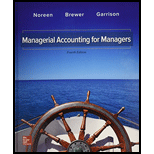
GEN COMBO MANAGERIAL ACCOUNTING FOR MANAGERS; CONNECT 1S ACCESS CARD
4th Edition
ISBN: 9781259911682
Author: Eric Noreen
Publisher: McGraw-Hill Education
expand_more
expand_more
format_list_bulleted
Question
Chapter 5, Problem 5.8E
To determine
Concept introduction:
Cost-volume-profit analysis:
This analysis focuses on the cost and volume of the product in order to calculate the operating profit. This analysis calculates the change in the operating product by the change in the cost and volume of the product.
Whether inventory has been increased, decreased, or remain unchanged.
Expert Solution & Answer
Want to see the full answer?
Check out a sample textbook solution
Students have asked these similar questions
Financial Accounting Question please answer
cost accounting
I am looking for a reliable way to solve this financial accounting problem using accurate principles.
Chapter 5 Solutions
GEN COMBO MANAGERIAL ACCOUNTING FOR MANAGERS; CONNECT 1S ACCESS CARD
Ch. 5 - Prob. 5.1QCh. 5 - Prob. 5.2QCh. 5 - Prob. 5.3QCh. 5 - Prob. 5.4QCh. 5 - Prob. 5.5QCh. 5 - Prob. 5.6QCh. 5 - Prob. 5.7QCh. 5 - Prob. 5.8QCh. 5 - Prob. 5.9QCh. 5 - Prob. 5.10Q
Ch. 5 - Prob. 5.11QCh. 5 - Prob. 5.12QCh. 5 - Prob. 5.13QCh. 5 - Prob. 5.14QCh. 5 - Prob. 5.15QCh. 5 - Prob. 5.16QCh. 5 - Prob. 5.17QCh. 5 - Prob. 1AECh. 5 - Prob. 1TF15Ch. 5 - Prob. 5.1ECh. 5 - Prob. 5.2ECh. 5 - Prob. 5.3ECh. 5 - Prob. 5.4ECh. 5 - Prob. 5.5ECh. 5 - Prob. 5.6ECh. 5 - Prob. 5.7ECh. 5 - Prob. 5.8ECh. 5 - Prob. 5.9ECh. 5 - Prob. 5.10ECh. 5 - Prob. 5.11ECh. 5 - Prob. 5.12ECh. 5 - Prob. 5.13ECh. 5 - Prob. 5.14ECh. 5 - Prob. 5.15ECh. 5 - Prob. 5.16ECh. 5 - Prob. 5.17ECh. 5 - Prob. 5.18PCh. 5 - Prob. 5.19PCh. 5 - Prob. 5.20PCh. 5 - Prob. 5.21PCh. 5 - Prob. 5.22PCh. 5 - Prob. 5.23PCh. 5 - Prob. 5.24PCh. 5 - Prob. 5.25PCh. 5 - Prob. 5.26PCh. 5 - Prob. 5.27PCh. 5 - Prob. 5.28PCh. 5 - Prob. 5.29CCh. 5 - Prob. 5.30C
Knowledge Booster
Similar questions
arrow_back_ios
SEE MORE QUESTIONS
arrow_forward_ios
Recommended textbooks for you

 AccountingAccountingISBN:9781337272094Author:WARREN, Carl S., Reeve, James M., Duchac, Jonathan E.Publisher:Cengage Learning,
AccountingAccountingISBN:9781337272094Author:WARREN, Carl S., Reeve, James M., Duchac, Jonathan E.Publisher:Cengage Learning, Accounting Information SystemsAccountingISBN:9781337619202Author:Hall, James A.Publisher:Cengage Learning,
Accounting Information SystemsAccountingISBN:9781337619202Author:Hall, James A.Publisher:Cengage Learning, Horngren's Cost Accounting: A Managerial Emphasis...AccountingISBN:9780134475585Author:Srikant M. Datar, Madhav V. RajanPublisher:PEARSON
Horngren's Cost Accounting: A Managerial Emphasis...AccountingISBN:9780134475585Author:Srikant M. Datar, Madhav V. RajanPublisher:PEARSON Intermediate AccountingAccountingISBN:9781259722660Author:J. David Spiceland, Mark W. Nelson, Wayne M ThomasPublisher:McGraw-Hill Education
Intermediate AccountingAccountingISBN:9781259722660Author:J. David Spiceland, Mark W. Nelson, Wayne M ThomasPublisher:McGraw-Hill Education Financial and Managerial AccountingAccountingISBN:9781259726705Author:John J Wild, Ken W. Shaw, Barbara Chiappetta Fundamental Accounting PrinciplesPublisher:McGraw-Hill Education
Financial and Managerial AccountingAccountingISBN:9781259726705Author:John J Wild, Ken W. Shaw, Barbara Chiappetta Fundamental Accounting PrinciplesPublisher:McGraw-Hill Education


Accounting
Accounting
ISBN:9781337272094
Author:WARREN, Carl S., Reeve, James M., Duchac, Jonathan E.
Publisher:Cengage Learning,

Accounting Information Systems
Accounting
ISBN:9781337619202
Author:Hall, James A.
Publisher:Cengage Learning,

Horngren's Cost Accounting: A Managerial Emphasis...
Accounting
ISBN:9780134475585
Author:Srikant M. Datar, Madhav V. Rajan
Publisher:PEARSON

Intermediate Accounting
Accounting
ISBN:9781259722660
Author:J. David Spiceland, Mark W. Nelson, Wayne M Thomas
Publisher:McGraw-Hill Education

Financial and Managerial Accounting
Accounting
ISBN:9781259726705
Author:John J Wild, Ken W. Shaw, Barbara Chiappetta Fundamental Accounting Principles
Publisher:McGraw-Hill Education